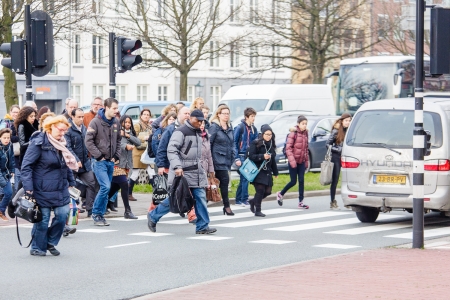There are four kinds of pedestrian provisions:
- Provisions that lower the speed of motor vehicles; referring to raised junctions, speed humps, axis offsets and 30 km/h zones.
- Provisions that separate motor vehicles and pedestrians by time; referring to different kinds of traffic light control.
- Provisions that separate motor vehicles and pedestrians by place; referring to bridges, tunnels, viaducts, pavements and central islands.
- Provisions that increase visibility and conspicuousness; referring to lighting, markings, signing, and relocation of lay-bys, bus stops and other sight obstructions.
Not all provisions mentioned above are equally effective. By and large, provisions that lower driving speeds or seperate transport modes by place are most effective [15].
Sustainably safe pedestrian crossings
Requirements for a sustainably safe pedestrian crossing are [16]:
- traffic calming measures with either horizontal speed reduction such as road narrowing, or vertical speed reduction such as speed humps or raised junctions;
- zebra marking parallel to the carriageway;
- zebra marking continuing across parallel bicycle tracks;
- traffic sign ‘pedestrian crossing' (L2) at some distance prior to the zebra crossing;
- illuminated L2 sign above the zebra crossing, on a gantry;
- appropriate lighting, preferably in a contrasting colour;
- profiled paving of the pedestrian route towards the zebra crossing;
- studded paving at the start and end of the zebra crossing, and sloping access curbing if the zebra is not on a raised junction;
- minimal zebra width is 4 metres;
- minimal crossover length, possibly with refuge.
A sustainably safe pedestrian crossing should only be constructed for urban area distributor roads that have a 50 km/h speed limit, physical separation of driving directions and a single lane for each driving direction (see SWOV fact sheet Principles for safe road design ). The most fundamental requirement is physical speed reduction; a motor vehicle must only ever approach a pedestrian crossing at a maximum speed of 30 km/h.
